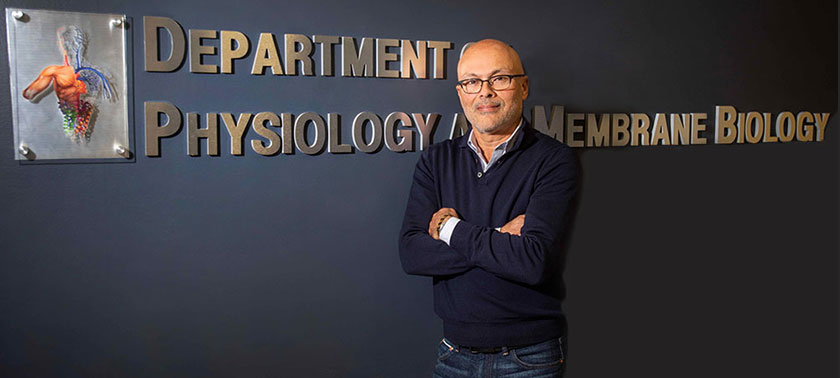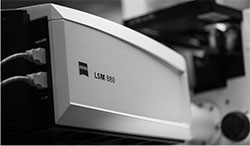Luis Fernando Santana, Ph.D.

Distinguished Professor and Chair | Vice Dean for Basic Sciences | 4305 Tupper Hall | Davis Campus
530-752-8836 | lfsantana@heatlh.ucdavis.edu | Curriculum Vitae | Lab Website | Leadership Bio
Research Interests
CA2+ SIGNALING IN CARDIAC AND VASCULAR SMOOTH MUSCLE
Research in our laboratory focuses on cardiac and vascular smooth muscle. We are particularly interested in determining how cell-wide (or global) and local changes in Ca2+ modulate the function of these cells. To investigate this we combine a series of state-of-the-art techniques including patch-clamp electrophysiology, molecular biology, cell biology, confocal and two-photon microscopy.
There are two ongoing projects in the laboratory. The goal of one of our projects is to investigate the molecular mechanisms underlying arrhythmias during heart failure (HF). Arrhythmias are the major cause of death during heart failure, yet their molecular causes are incompletely understood. Recent reports suggest that an increase in the duration of the action potential (AP) of cardiac myocytes is the major arrhythmogenic event during HF. Interestingly, this prolongation of the AP of failing cardiac myocytes occurs in the absence of known genetic changes that affect membrane currents. Recent work in the lab suggests that post-translational glycosylation of Na+ and K+ channel proteins is altered during HF. Deficient de-glycosylation alter the currents produced by Na+ and K+ channels in ways that increase AP duration and arrhythmogenesis. Current experiments examine the cellular and molecular changes in cardiac cells leading to defective glycosylation of ion channels during HF.
The other project that our laboratory is working on focuses on the mechanisms controlling the diameter of cerebral arteries, which controls blood flow to the brain. The contractile state of vascular smooth muscle cells is ultimately responsible for the regulation of arterial diameter. It has been well established that increases in intravascular pressure constrict cerebral arteries via membrane depolarization of vascular smooth muscle cells, which increases the steady-state open probability of Ca2+ channels. The opening of Ca2+ channels, in turn, increases Ca2+ influx and causes a or global increase in [Ca2+]i that causes arterial constriction. Ca2+ channels have been traditionally thought to control [Ca2+]i by supplying Ca2+ directly to the cytosol and by stimulating Ca2+ release through ryanodine receptors (RyRs) in the sarcoplasmic reticulum (SR). However, we showed that localized Ca2+ release events through RyRs, called "Ca2+ sparks" acting as a negative feedback element, stimulate nearby Ca2+-activated potassium (KCa) channels to cause membrane potential hyperpolarization and thus a reduction in activity of Ca2+ channel activity which causes a reduction in global [Ca2+]i and relaxes vascular smooth muscle cells. These results suggested that the strength and efficacy of Ca2+ signals from Ca2+ channels to RyRs and KCa channels, as well as from RyRs to Ca2+ channels and KCa channels depends on the relative location of these proteins, their sensitivity to Ca2+, and the frequency and amplitude of the local Ca2+ signals. We recently found that these Ca2+ signals are profoundly altered by vasodilators that elevate cAMP (i.e. forskolin) and cGMP (e.g. nitric oxide). Current experiments are aimed at examining, at the molecular level, the mechanism by which these vasodilators modulate the communication among KCa, RyRs and Ca2+ channels via Ca2+ signals.
An updated list of current publications: Google Scholar
Ren L, Thai PN, Gopireddy RR, Timofeyev V, Ledford HA, Woltz RL, Park S, Puglisi JL, Moreno CM, Santana LF, Conti AC, Kotlikoff MI, Xiang YK, Yarov-Yarovoy V, Zaccolo M, Zhang XD, Yamoah EN, Navedo MF, and Chiamvimonvat N. "Adenylyl cyclase isoform 1 contributes to sinoatrial node automaticity via functional microdomains". JCI Insight 7: 2022.
Manning D, and Santana LF. "Regulating voltage-gated ion channels with nanobodies". Nat Commun 13: 7557, 2022.
Guarina L, Moghbel AN, Pourhosseinzadeh MS, Cudmore RH, Sato D, Clancy CE, and Santana LF. "Biological noise is a key determinant of the reproducibility and adaptability of cardiac pacemaking and EC coupling". J Gen Physiol 154: 2022.
Grainger N, and Santana LF. "The Central Brain of the Heart: The Sinoatrial Node". JACC Clin Electrophysiol 8: 1216-1218, 2022.
Grainger N, and Santana LF. "The Inferior Sinoatrial Node Suffers the Most During Heart Failure". JACC Clin Electrophysiol 8: 1354-1356, 2022.
Earley S, Santana LF, and Lederer WJ. "The physiological sensor channels TRP and piezo: Nobel Prize in Physiology or Medicine 2021". Physiol Rev 102: 1153-1158, 2022.
Dixon RE, Navedo MF, Binder MD, and Santana LF. "Mechanisms and physiological implications of cooperative gating of clustered ion channels". Physiol Rev 102: 1159-1210, 2022.
Cudmore RH, and Santana LF. "Piezo1 Tunes Blood Flow in the Central Nervous System". Circ Res 130: 1547-1549, 2022.
Vierra, N. C., O’Dwyer, S. C., Matsumoto, C., Santana, L. F., and J. S. Trimmer. (2021). "Regulation of Neuronal Excitation-Transcription Coupling by Kv2.1-induced Clustering of Somatic L-type Ca2+ Channels at ER-PM Junctions". Proc. Nat. Acad. Sci. USA 118 (46):e2110094118. PMID: 34750263.
Vierra, N. C., Kirmiz, M., van der List, D., Santana, L. F., and J. S. Trimmer. (2019). "Kv2.1 Mediates Spatial and Functional Coupling of L-type Calcium Channels and Ryanodine Receptors in Neurons". eLife 8: e49953. PMID: 31663850.
Dong, J.-X., Lee, Y., Kirmiz, M., Palacio, S., Dumitras, C., Moreno, C. M., Sando, R., Santana, L. F., Südhof, T. C., Gong, B., Murray, K. D., and J. S. Trimmer. (2019). "A Toolbox of Nanobodies Developed and Validated for Diverse Neuroscience Research Applications". eLife 8:e48750. PMID: 31566565.
Sato, D., Hernández-Hernández, G., Matsumoto, C., Tajada, S., Moreno, C. M., Dixon, R. E., O'Dwyer, S., Navedo, M. F., Trimmer, J. S., Clancy, C. E., Binder, M. D., and L. F. Santana. (2019). "A Stochastic Model of Ion Channel Cluster Formation in the Plasma Membrane". J. Gen. Physiol. 151:1116-1134. PMID: 31371391.
Sato, D., R.E. Dixon, L.F. Santana, and M.F. Navedo (2018). "A model for cooperative gating of L-type Ca2+ channels and its effects on cardiac alternans dynamics". PLoS Comput Biol. 14:e1005906.
Vivas, O., C.M. Moreno, L.F. Santana, and B. Hille (2017). "Proximal clustering between BK and CaV1.3 channels promotes functional coupling and BK channel activation at low voltage". eLife. 6.
Tajada, S., C.M. Moreno, S. O'Dwyer, S. Woods, D. Sato, M.F. Navedo, and L.F. Santana (2017). "Distance constraints on activation of TRPV4 channels by AKAP150-bound PKCalpha in arterial myocytes". J Gen Physiol. 149:639-659.
Nieves-Cintron, M., A.U. Syed, O.R. Buonarati, R.R. Rigor, M.A. Nystoriak, D. Ghosh, K.C. Sasse, S.M. Ward, L.F. Santana, J.W. Hell, and M.F. Navedo (2017). "Impaired BKCa channel function in native vascular smooth muscle from humans with type 2 diabetes". Sci Rep. 7:14058.
Li, L., J. Li, B.M. Drum, Y. Chen, H. Yin, X. Guo, S.W. Luckey, M.L. Gilbert, G.S. McKnight, J.D. Scott, L.F. Santana, and Q. Liu (2017). "Loss of AKAP150 promotes pathological remodelling and heart failure propensity by disrupting calcium cycling and contractile reserve". Cardiovascular research. 113:147-159.
Ghosh, D., A.U. Syed, M.P. Prada, M.A. Nystoriak, L.F. Santana, M. Nieves-Cintron, and M.F. Navedo (2017). "Calcium Channels in Vascular Smooth Muscle". Adv Pharmacol. 78:49-87.
Gentil, B.J., E. O'Ferrall, C. Chalk, L.F. Santana, H.D. Durham, and R. Massie (2017). "A New Mutation in FIG4 Causes a Severe Form of CMT4J Involving TRPV4 in the Pathogenic Cascade". J Neuropathol Exp Neurol. 76:789-799.
Nieves-Cintron, M., D. Hirenallur-Shanthappa, P.J. Nygren, S.A. Hinke, M.L. Dell'Acqua, L.K. Langeberg, M. Navedo, L.F. Santana, and J.D. Scott (2016). "AKAP150 participates in calcineurin/NFAT activation during the down-regulation of voltage-gated K+ currents in ventricular myocytes following myocardial infarction". Cell Signal. 28:733-740
Moreno, C. M., R. E. Dixon, S. Tajada, C. Yuan, X. Opitz-Araya, M. D. Binder and L. F. Santana (2016). "Ca2+ entry into neurons is facilitated by cooperative gating of clustered Ca1.3 channels". Elife 5.
- News release: Open-access journal eLife gets £25-million boost




 Make a donation using our secure online system.
Make a donation using our secure online system.